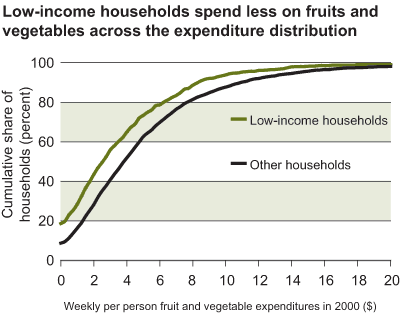Low-Income Households Spend Less on Fruits and Vegetables
- by Noel Blisard
- 6/1/2004
Americans’ consumption of fruits and vegetables falls short of Food Guide Pyramid recommendations. But not for lack of choice (see “Global Trade in Fruits and Vegetables Brings Variety to the Nation’s Grocery Stores”). Still, the Produce for Better Health Foundation found that only 38 percent of Americans consumed the recommended 3-5 daily servings of vegetables, while just 23 percent consumed the recommended 2-4 servings of fruit.
Other research has shown that low-income households (those households with incomes less than or equal to 130 percent of the poverty line) consume even less fruits and vegetables, prompting ERS researchers to compare the choices that low-income and high-income households make at the grocery store. Nineteen percent of low-income households (versus 10 percent of higher income households) bought no fruits and vegetables from grocery stores and other at-home sources over a 2-week survey period in 2000. This gap persisted over the entire expenditure distribution. For example, half of the low-income households had weekly fruit and vegetable purchases of $2.50 or less per person, whereas half of higher income households had per person expenditures of $4 or less. This gap in the expenditure distributions includes significant differences in average fruit and vegetable expenditures—$3.59 per person per week for low-income households versus $5.02 for higher income households. These results held when purchases were broken out into just fresh or just processed fruits and vegetables.
The ERS study also examined how spending by low-income households would change if they received a marginal amount of additional income. That is, would small increases in their incomes be spent on additional fruits and vegetables, or on other food or nonfood items, such as meats, cereals, bakery products, or clothing? The ERS study found that small changes in income had a positive and statistically significant effect on fruit and vegetable spending by higher income households, but had no impact on spending by low-income households. Low-income households may perceive other goods as more essential to the household than fruits and vegetables, and would thus spend small increases in income on these items.
Interestingly, the largest positive influence on fruit and vegetable expenditures was having a college-educated head of household, regardless of income level. In fact, college-educated households had the highest level of per capita fruit and vegetable expenditures ($5.99 per person per week).
This article is drawn from:
- Blisard, N., Stewart, H. & Jolliffe, D. (2004). Low-Income Households' Expenditures on Fruits and Vegetables. U.S. Department of Agriculture, Economic Research Service. AIB-792-5.


